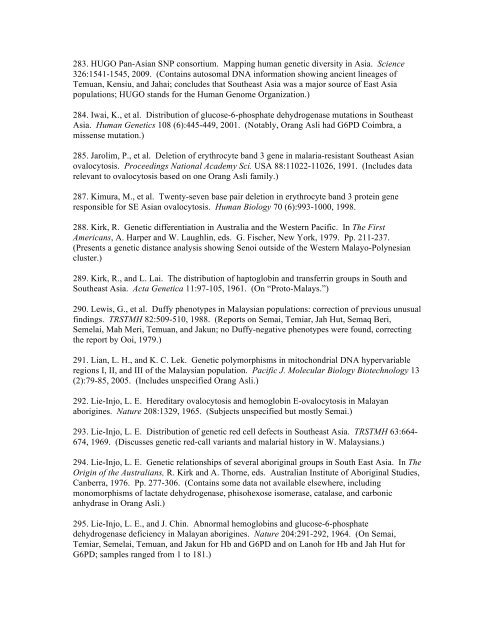Orang Asli (Indigenous Malaysian) Biomedical Bibliography AS Baer
Orang Asli (Indigenous Malaysian) Biomedical Bibliography AS Baer
Orang Asli (Indigenous Malaysian) Biomedical Bibliography AS Baer
Create successful ePaper yourself
Turn your PDF publications into a flip-book with our unique Google optimized e-Paper software.
283. HUGO Pan-Asian SNP consortium. Mapping human genetic diversity in Asia. Science<br />
326:1541-1545, 2009. (Contains autosomal DNA information showing ancient lineages of<br />
Temuan, Kensiu, and Jahai; concludes that Southeast Asia was a major source of East Asia<br />
populations; HUGO stands for the Human Genome Organization.)<br />
284. Iwai, K., et al. Distribution of glucose-6-phosphate dehydrogenase mutations in Southeast<br />
Asia. Human Genetics 108 (6):445-449, 2001. (Notably, <strong>Orang</strong> <strong>Asli</strong> had G6PD Coimbra, a<br />
missense mutation.)<br />
285. Jarolim, P., et al. Deletion of erythrocyte band 3 gene in malaria-resistant Southeast Asian<br />
ovalocytosis. Proceedings National Academy Sci. USA 88:11022-11026, 1991. (Includes data<br />
relevant to ovalocytosis based on one <strong>Orang</strong> <strong>Asli</strong> family.)<br />
287. Kimura, M., et al. Twenty-seven base pair deletion in erythrocyte band 3 protein gene<br />
responsible for SE Asian ovalocytosis. Human Biology 70 (6):993-1000, 1998.<br />
288. Kirk, R. Genetic differentiation in Australia and the Western Pacific. In The First<br />
Americans, A. Harper and W. Laughlin, eds. G. Fischer, New York, 1979. Pp. 211-237.<br />
(Presents a genetic distance analysis showing Senoi outside of the Western Malayo-Polynesian<br />
cluster.)<br />
289. Kirk, R., and L. Lai. The distribution of haptoglobin and transferrin groups in South and<br />
Southeast Asia. Acta Genetica 11:97-105, 1961. (On “Proto-Malays.”)<br />
290. Lewis, G., et al. Duffy phenotypes in <strong>Malaysian</strong> populations: correction of previous unusual<br />
findings. TRSTMH 82:509-510, 1988. (Reports on Semai, Temiar, Jah Hut, Semaq Beri,<br />
Semelai, Mah Meri, Temuan, and Jakun; no Duffy-negative phenotypes were found, correcting<br />
the report by Ooi, 1979.)<br />
291. Lian, L. H., and K. C. Lek. Genetic polymorphisms in mitochondrial DNA hypervariable<br />
regions I, II, and III of the <strong>Malaysian</strong> population. Pacific J. Molecular Biology Biotechnology 13<br />
(2):79-85, 2005. (Includes unspecified <strong>Orang</strong> <strong>Asli</strong>.)<br />
292. Lie-Injo, L. E. Hereditary ovalocytosis and hemoglobin E-ovalocytosis in Malayan<br />
aborigines. Nature 208:1329, 1965. (Subjects unspecified but mostly Semai.)<br />
293. Lie-Injo, L. E. Distribution of genetic red cell defects in Southeast Asia. TRSTMH 63:664-<br />
674, 1969. (Discusses genetic red-call variants and malarial history in W. <strong>Malaysian</strong>s.)<br />
294. Lie-Injo, L. E. Genetic relationships of several aboriginal groups in South East Asia. In The<br />
Origin of the Australians, R. Kirk and A. Thorne, eds. Australian Institute of Aboriginal Studies,<br />
Canberra, 1976. Pp. 277-306. (Contains some data not available elsewhere, including<br />
monomorphisms of lactate dehydrogenase, phisohexose isomerase, catalase, and carbonic<br />
anhydrase in <strong>Orang</strong> <strong>Asli</strong>.)<br />
295. Lie-Injo, L. E., and J. Chin. Abnormal hemoglobins and glucose-6-phosphate<br />
dehydrogenase deficiency in Malayan aborigines. Nature 204:291-292, 1964. (On Semai,<br />
Temiar, Semelai, Temuan, and Jakun for Hb and G6PD and on Lanoh for Hb and Jah Hut for<br />
G6PD; samples ranged from 1 to 181.)















